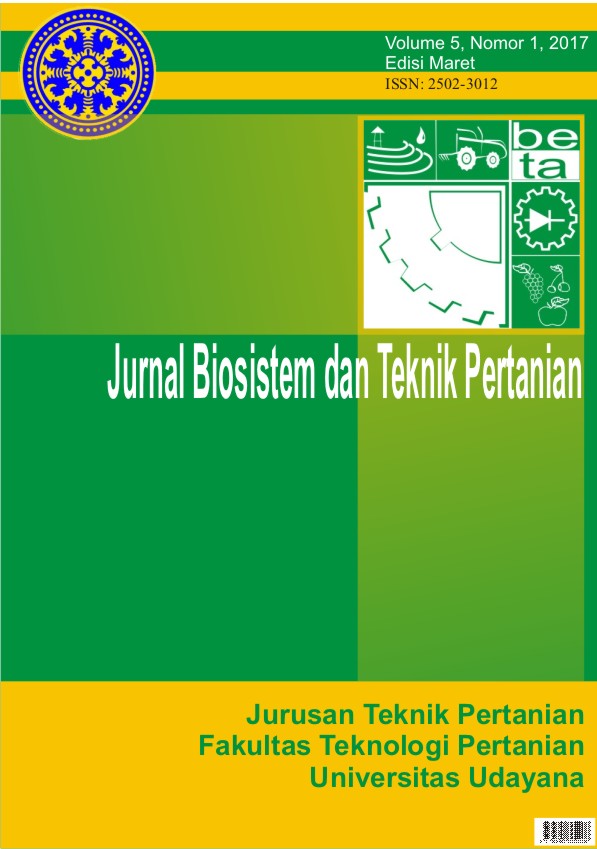Analisis Pemakaian Air Irigasi Pada Budidaya Padi Beras Merah dengan Sistem Tanam Legowo Nyisip(Studi Kasus di Subak Sigaran)
Abstract
Penelitian ini dilakukan untuk mengetahui pemakaian air irigasi pada budidaya padi beras merah dengan sistem tanam legowo nyisip dan membandingkan produktivitas pada setiap perlakuan. Penelitian ini terdiri dari lima perlakuan, yaitu: K0 (konvensional, sesuai kebiasaan petani setempat), K1 (sistem tanam legowo 4:1), K2 (sistem tanam legowo 4:1 nyisip), K3 (sistem tanam legowo 6:1), K4 (sistem tanam legowo 6:1 nyisip). Parameter yang diamati dalam penelitian ini adalah: kebutuhan air irigasi, efisiensi penggunaan air irigasi, jumlah anakan berbuah, panjang malai, jumlah biji padi per malai, berat gabah per rumpun, persentase gabah isi basis jumlah, persentase gabah isi basis berat, berat 1000 butir gabah isi dan hasil produksi tanaman padi. Hasil penelitian menunjukan perbedaan sistem budidaya sesuai perlakuan tidak berpengaruh terhadap kebutuhan air irigasi tiap perlakuan dan efisiensi relatif. Pada produktivitas K0 menghasilkan 5.4 ton/ha, K1 menghasilkan 7.8 ton/ha, K2 menghasilkan 7.2 ton/ha, K3 menghasilkan 7.7 ton/ha, dan K4 menghasilkan 6.5 ton/ha.
This researce is conducted to compare the usage of irrigation water to the cultivation red rice plants by using planting sytem of legowo nyisip and compare productivity on every action. This research was consist of five treatments, they were : K0 (the treatment which appropriated to local farmers custom), K1 (planting system of legowo 4:1), K2 (planting sytem of legowo 4:1 nyisip), K3 (planting sytem of legowo 6:1), K4 (planting system of legowo 6:1 nyisip). Parameters that observed in this research are: the requirement of irrigation water, the efficiency of irrigation water using ,the number of plants produce grains, the stalks length, the weight of rice in a clump, percentage pure rice , the percentage of rice based on its amount, the percentage of rice based on its weight , the weight of 1000 grains and the result rice plants production. The research results show significant differences with cultivation technique between the treatments is no influence to the requirement of irrigation water and efficiency relative in every treatments. To productivity KO produced 5.4 ton/ha, K1 produced 7.8 ton/ha, K2 produced 7:2 ton/ha, K3 produced 7:7 ton/ha, and K4 produced 6:5 ton/ha.
Downloads
References
De Datta, S. K. 1981. Principles and Practices of Rice Production. John Wiley & Sons, Inc.Canada. 618p.
Hamzah, Z. Dan Atman. 2000. Pemberian Pupuk SP36 dan System Tanam Padi Sawah Varietas Cisokan. Prosiding Seminar Nasional Hasil-Hasil Penelitian Dan Pengkajian Pertanian. Buku I. Puslitbang Sosial Ekonomi Pertanian Bogor; 89-92 Hlm.
Hatta, M. 2012. Uji Jarak Tanam Sistem Legowo Terhadap Pertumbuhan Dan Hasil Beberapa Varietas Padi Pada Metode SRI. Staf Pengajar Program Studi Agroteknologi Fakultas Pertanian Unsyiah, Banda Aceh.
Hendra, I Putu. 2014. Kajian Jarak Legowo Pada Budidaya Padi Sistem Jajar Legowo (Studi Kasus di Subak Suala, Desa Pitera, Kec. Penebel, Kab. Tabanan). Fakultas Teknologi Pertanian. Universitas Udayana. Bali.
Lin, XQ, D.F. Zhu, H.Z. Chen, and Y.P. Zhang. 2009. Effects of Plant Density and Nitrogen Application Rate On Grain Yield And Nitrogen Uptake Of Super Hybrid Rice. Rice Science 16(2):138-142
Ludgerius, Paul. 2015. “Aplikasi Metode SRI dan Sistem Tanam Jajar Legowo Terhadap Iklim Mikro yang Mempengaruhi Produktivitas Padi Beras Merah”. (Studi Kasus di Subak Suala, Desa Pitera, Kec. Penebel, Kab. Tabanan) Fakultas Teknologi Pertanian. Universitas Udayana. Bali.
Manan dan Suhardianto, 1999.Penelitian Agroklimat dan Pengembangan Database Sumberdaya Iklim untuk meningkatkan Hasil Pertanian di Sulawesi Tenggara. Laporan Penelitian. Pusat Penelitan Tanah dan Agroklimat. Bogor.
Masdar, Musliar. K, Bujang R., Nurhajati H., Helmi. 2006. Tingkat Hasil Dan Komponen Hasil Sistem Intensifikasi Padi (SRI) Tanpa Pupuk Organik Di Daerah Curah Hujan Tinggi. Jurnal Ilmu-Ilmu Pertanian Indonesia 8 (2):126-131.
Sudjarwadi. 1990. Teori dan Praktek Irigasi. Pusat Antar Universitas Ilmu Teknik, UGM. Yogyakarta.
Sohel, M. Siddique, M. Asaduzzaman, M. N. Alam, & M.M. Karim, 2009. Varietal Performance of Transplant Aman Rice under Different Hill Densities. Bangladesh J. Agril. Res. 34(1): 33 – 39.
Tisdale, S.L. and W.L. Nelson. 1966. Soil Fertility and Fertilizers. The Macmillan Company, New York.
Windia, W.2006.Transformasi Sistem Irigasi Subak yang Berlandaskan Tri Hita Karana,Denpasar:Pustaka Bali Post.












 Jurnal BETA (Biosistem dan Teknik Pertanian)
Jurnal BETA (Biosistem dan Teknik Pertanian)


